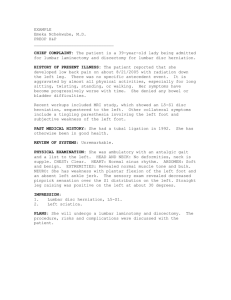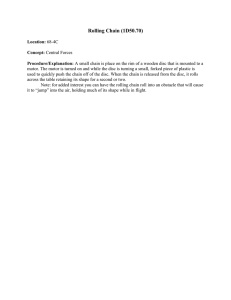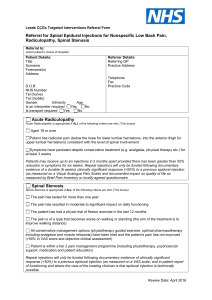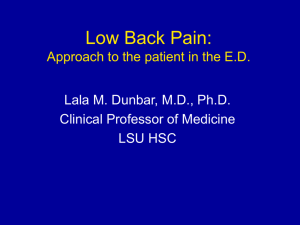L3-L4, L4-L5 Severe Spinal Stenosis Responds To Cox Technic
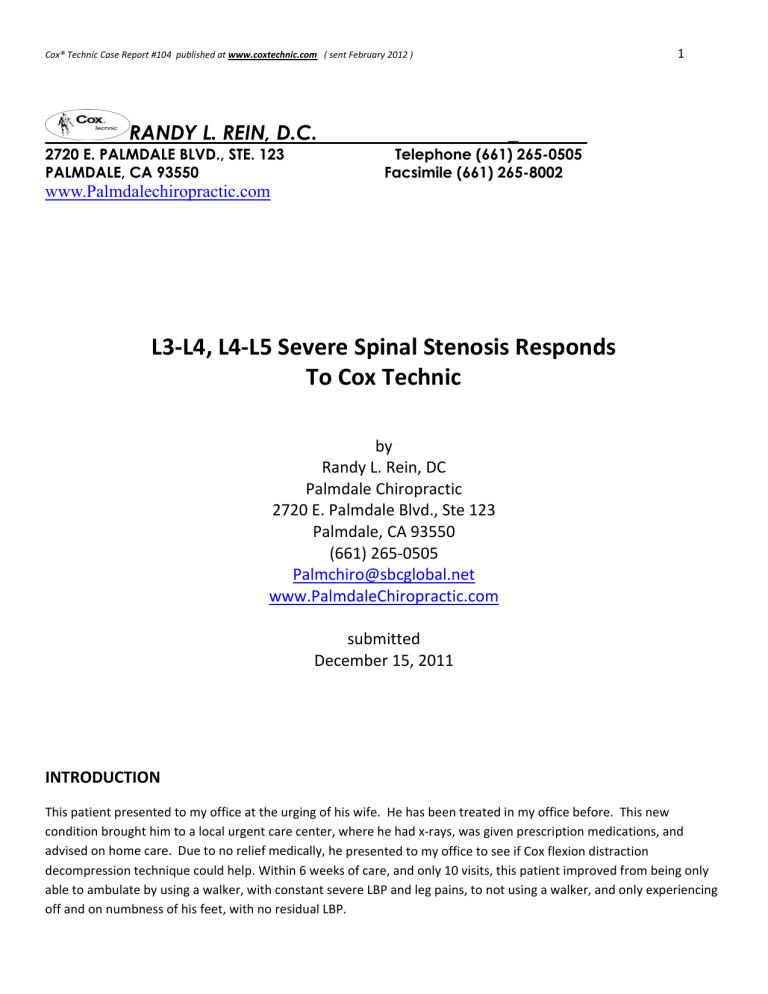
Cox® Technic Case Report #104 published at www.coxtechnic.com
( sent February 2012 )
1
D.C.
2720 E. PALMDALE BLVD., STE. 123 Telephone (661) 265-0505
PALMDALE, CA 93550 Facsimile (661) 265-8002 www.Palmdalechiropractic.com
L3
‐
L4,
L4
‐
L5
Severe
Spinal
Stenosis
Responds
To
Cox
Technic
by
Randy L.
Rein, DC
Palmdale Chiropractic
2720 E.
Palmdale Blvd., Ste 123
Palmdale, CA 93550
(661) 265 ‐ 0505
Palmchiro@sbcglobal.net
www.PalmdaleChiropractic.com
submitted
December 15, 2011
INTRODUCTION
This patient presented to my office at the urging of his wife.
He has been treated in my office before.
This new condition brought him to a local urgent care center, where he had x ‐ rays, was given prescription medications, and advised on home care.
Due to no relief medically, he presented to my office to see if Cox flexion distraction decompression technique could help.
Within 6 weeks of care, and only 10 visits, this patient improved from being only able to ambulate by using a walker, with constant severe LBP and leg pains, to not using a walker, and only experiencing off and on numbness of his feet, with no residual LBP.
Cox® Technic Case Report #104 published at www.coxtechnic.com
( sent February 2012 )
2
PRESENTATION & EXAMINATION FINDINGS
History/chief complaint: 78 year old Caucasian ‐ American male is seen for the chief complaint of lower back pain and pelvic pain with radiation of “220 volts” of pain, numbness and coldness down both legs to both feet and toes.
This started 2 weeks prior to using his brother ‐ in ‐ law’s “ankle machine”.
(Please see picture.)
He states he awoke one day after using the machine with the above stated symptoms while visiting said brother ‐ in ‐ law.
He stated he was able to sit without any pain and was able to drive his motor home back to the Los Angeles area from
Reno, but with great difficulty.
He initially used ice and did not see a medical doctor.
One week later, he went to an urgent care complaining of constipation and the above stated pain.
He had x ‐ rays, was given NSAIDs, told he had osteoarthritis, and released.
Upon entering my office, he was using a walker and was unable to ambulate without it.
He said his lower back pain was decreased, at a 3 to 4 of 10 on the VAS.
But he still had the same intensity of leg complaints.
His past medical history includes: Myocardial infarction, with subsequent triple bypass open heart surgery.
High cholesterol.
Motorcycle accident, causing 6 fractured ribs.
Left 4th finger traumatically amputated while using an axe.
Left femur fracture and surgery, with a metal plate attached to his femur.
And bilateral clavicle fractures.
Cox® Technic Case Report #104 published at www.coxtechnic.com
( sent February 2012 )
EXAMINATION:
3
Exam reveals the following positive findings: Minors sign, extremely slow, limping and with the aid of a walker gait, forward flexed antalgia standing posture, palpatory moderate sacral myotenderness, and mild myospasm.
Palpatory AS left ilium and PI right ilium malpositions, negative SLR, WLR, Bechterrew’s, Yoemans, and Elys tests.
Hypoesthesia to the bilateral L4, L5, and S1 dermatomes to pinwheel testing.
1+ bilateral patellar and Achilles deep tendon reflexes.
IMAGING:
Lumbar spine x ‐ rays performed at the urgent care center were sent for but never received.
AP and lateral lumbar spine x ‐ rays were performed in this office back on April 29, 2010, and were reviewed prior to treatment.
These revealed:
abdominal aorta calcification
L5 ‐ S1 mild to moderate degenerative disc disease
L3 retrolithesis
osteopenia
upper lumbar osteophytes
degenerative disc disease
MRI of the lumbar spine without contrast was performed and revealed the following in the MRI report.
(See images at
Figures 1, 2, 3.)
MRI ‐ LUMBAR SPINE WITHOUT CONTRAST
MRI LUMBAR SPINE WITHOUT CONTRAST ‐ AUGUST 6, 2011
INDICATIONS: Back pain,
COMPARISON: Lumbar spine plain films of July, 2011,
TECHNIQUE: An MRI of the lumbar spine was performed on a Philips Intera 1.5
tesla scanner utilizing the following sequences: Sagittal Tl~ weighted, sagittal T2 ‐ weighted, sagittal STIR, and axial dual ‐ echo T2 ‐ weighted fast spin ‐ echo,
FINDINGS: The posterior alignment is maintained.
No fractures are identified.
No nondegenerative marrow signal abnormalities are identified.
The conus medullaris is normal in appearance and ends appropriately at the Ll ‐ 2 intervertebral disc level.
The visualized abdominal aorta is not dilated.
The visualized sacrum is intact.
Findings by level:
L1 ‐ L2: There is normal disc height.
There is a mild generalized disc bulge.
There is superimposed 1 mm central posterior disc protrusion with annular fissure.
There is facet arthropathy.
There is mild bilateral neuroforaminal narrowing without central spinal stenosis.
Cox® Technic Case Report #104 published at www.coxtechnic.com
( sent February 2012 )
4
L2 ‐ L3: There is mild loss of disc height.
There is mild generalized disc bulge.
There is mild facet arthropathy with ligamentum flavum thickening.
There is mild bilateral neuroforaminal narrowing without central spinal stenosis,
L3 ‐ L4: There is mild loss of disc height.
There is a generalized disc bulge with superimposed 4 mm central posterior disc protrusion.
There is severe facet arthropathy with ligamentum flavum thickening.
There is prominence of the epidural fat.
Findings contribute to moderate severe left sided and mild moderate right sided neuroforaminal narrowing with severe bilateral lateral recess stenosis and severe central spinal stenosis with AP diameter of the central canal of 3 ‐ 4 mm.
L4 ‐ L5: There is normal disc height.
There is mild generalized disc bulge with superimposed right central posterior disc protrusion measuring 2 mm.
There is severe facet arthropathy with ligamentum flavum thickening.
There is severe bilateral lateral recess stenosis with moderate ‐ to ‐ severe bilateral neuroforaminal narrowing and severe central spinal stenosis with AP diameter of the central canal of 4 mm.
L5 ‐ S1: There is normal disc height.
There is mild generalized disc bulge with superimposed 2 mm central posterior disc protrusion, There is facet arthropathy.
There is mild moderate left sided and moderate severe right sided neuroforaminal narrowing without central spinal stenosis.
IMPRESSION:
1.
Multilevel degenerative changes as described, most pronounced at L3 ‐ 4 and L4 ‐ 5.
2.
At L3 ‐ 4, there is severe bilateral lateral recess stenosis, with advanced bilateral neuroforaminal narrowing and central spinal stenosis.
3.
At L4 ‐ 5, there is severe bilateral lateral recess stenosis with bilateral neuroforaminal narrowing and central spinal stenosis.
Cox® Technic Case Report #104 published at www.coxtechnic.com
( sent February 2012 )
5
Figure 1: Sagittal T1 weighted study
Figure 2: Axial L3 ‐ L4 T1 weighted study
Figure 3: Axial L4 ‐ L5 T1 weighted study
Cox® Technic Case Report #104 published at www.coxtechnic.com
( sent February 2012 )
DIAGNOSIS:
1.
L3 ‐ L4, L4 ‐ L5 central canal, and lateral recess stenosis.
2.
Bilateral sciatica/neuritis.
3.
Lumbar disc degeneration.
4.
Lumbar spondylosis.
5.
Ilium segmental dysfunction.
TREATMENT:
6
Cox flexion ‐ distraction decompression manipulation to the lumbar spine was performed.
Protocol #1, contact at L2 level.
Adjunctive physiotherapy of soft tissue massage, heat, and low volt positive galvanic electrical muscle stimulation was performed to the L3 ‐ S1 paraspinal muscle levels, and to the posterior knee (Popliteal fossa regions) bilaterally.
The patient was advised on homecare, including lumbar exercises, and heat to be performed twice daily.
The patient was treated on July 11th, 13th, 15th, and the 18th.
At that time he stated he was improved, was not using his walker as much, and upon waking he had less LBP.
He also stated he was going to see his MD.
He called on July 20th and stated that he had additional x ‐ rays, that he was scheduled for a steroid injection in one week, and that he would follow ‐ up with us thereafter.
He returned to my office on August 12th.
He states his MD sent him for an MRI, and that he was doing better, but he did not have the injection.
He had just rested since his last visit in this office.
He again was treated on the 12th, 15th,
17th, 22nd, 24th, and lastly on the 28th.
When last seen on the 28th, he presented with no LBP and only complained of off ‐ and ‐ on numbness and coldness of his feet.
He did not use a walker and was able to walk any distance, but he felt that he needed “to be careful”.
He is not taking any medications and has not been performing his lumbar exercises.
Final exam revealed no palpatory tenderness and no spasms or hypertonicity.
Gait was within normal limits, negative
Minors Sign, and negative orthopedic testing including Kemps, Elys, SLR and WLR.
DISCUSSION:
Obviously the patient had these degenerative changes prior to this “ankle machine” incident.
His degenerative changes were inactive and asymptomatic, but became active as a result of this incident.
The patient was recommended to continue with supportive care on a twice per month basis.
The purpose of such is to maintain him at his current level of symptomatology and prevent and/or limit him from any exacerbations of his lower back and leg complaints.
Clinically, the goal is to maintain disc space, maintain physiologic ranges of motion, and continue to promote osseoligamentous canal space, thus maintaining a lack of nerve root compression.
Unfortunately, the patient did not heed my advice and has discontinued his care, stating it was due to financial reasons.
Cox® Technic Case Report #104 published at www.coxtechnic.com
( sent February 2012 )
7
CONCLUSION:
This patient was treated with Cox flexion ‐ distraction decompression manipulation and obtained excellent results, despite his severe documented MRI findings.
He did not respond to conventional medical care.
Conservative non force
Cox chiropractic care is safer, gentler and more effective in the treatment of degenerative disorders of the lumbar spine.
And there are typically no side effects versus prescription medications, including steroids and NSAIDs.
Patients with very severe degenerative changes are difficult to help at times, but in this case, success occurred.
REFERENCES:
1.
Snow G: Chiropractic management of a patient with lumbar spinal stenosis .
JMPT 2001; 24(4): 300 ‐ 304
2.
DuPriest CM: Nonoperative management of lumbar spinal stenosis .
Journal of Manipulative and Physiological
Therapeutics 1993;16(6):411 ‐ 4
3.
Gudavalli R, Cambron JA, McGregor M et al: A randomized clinical trial and subgroup analysis to compare flexion– distraction with active exercise for chronic low back pain .
European Spine Journal 2006; 15: 1070 ‐ 1082

